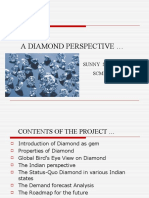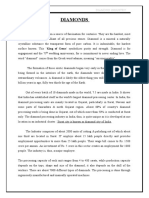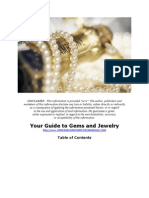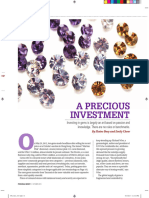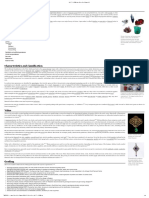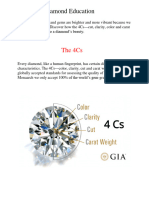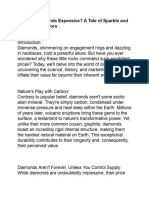0 ratings0% found this document useful (0 votes)
2 viewsDiamond - Fair 22.07.09
Diamond - Fair 22.07.09
Uploaded by
riturajgarhia1969Copyright:
© All Rights Reserved
Available Formats
Download as DOC, PDF, TXT or read online from Scribd
Diamond - Fair 22.07.09
Diamond - Fair 22.07.09
Uploaded by
riturajgarhia19690 ratings0% found this document useful (0 votes)
2 views3 pagesCopyright
© © All Rights Reserved
Available Formats
DOC, PDF, TXT or read online from Scribd
Share this document
Did you find this document useful?
Is this content inappropriate?
Copyright:
© All Rights Reserved
Available Formats
Download as DOC, PDF, TXT or read online from Scribd
Download as doc, pdf, or txt
0 ratings0% found this document useful (0 votes)
2 views3 pagesDiamond - Fair 22.07.09
Diamond - Fair 22.07.09
Uploaded by
riturajgarhia1969Copyright:
© All Rights Reserved
Available Formats
Download as DOC, PDF, TXT or read online from Scribd
Download as doc, pdf, or txt
You are on page 1of 3
Diamond
History: The mention of the word diamond is enough to bring a smile to a
person's face, and especially to those of the feminine gender. It's beautiful
sparkle and excellent luster has made it the most prized gemstone among all
strata of society, and to have a diamond in one's jewelry box is often seen as
an indication of a person's monetary worth. The great value attached to
diamond can be seen from the fact that the money spent in purchasing
diamonds worldwide is far greater than that spent on purchasing all other
gemstones put together.
Diamonds are created deep within the earth's crust, about hundred miles
below the surface, where the temperature and pressure is extremely high.
Due to the volcanic eruptions the stones come to the earth’s surface in
mantle rock known as xenoliths, from where they are mined.
Diamonds are graded into two kinds, those valued for their beauty as
gemstones and the ones which have only the quality of hardness and are
lacking in colour and clarity. These are used in industry.
Diamond is a chemically resistant stone and due to this its application in
industry is also widespread especially as a cutting tool.
Chemical Composition: It is made up of carbon, and in the diamond each
carbon atom is surrounded by four other carbon atoms by strong covalent
bonds. This simple bonded arrangement has created one of the strongest
known substances known to man.
Physical Properties: It has a hardness of 10 on the Moh’s scale, with a
specific gravity of 3.5 - 3.6. Its crystal system is isometric and it has perfect
cleavage. It is a transparent stone with an adamantine luster, which is the
highest rated for nonmetallic minerals.
Color: Gem quality diamonds are generally colorless with some yellow tints
being permissible. In the modern times tough, the red, yellow, purple, green
and even blue variety, which are called “fancy diamonds” are gaining in
popularity.
Cut: Diamonds can be appropriated in any shapes, from round, oval,
Princess cut, cushion cut, Emerald cut, squares, Marquise and pear cuts. The
faceting of the stone is a very important component since it is this which
enhances the reflective quality as well as the stones luster and fire.
Carat: Diamonds are available in all sizes, from the smallest to the biggest
and some of the most famous items of jewelry in the world are adorned by
exceptionally big sizes and are considered as national treasures. Among
these are the crown jewels of British monarchs, which featured the Kohinoor
and the star of Africa, some of the most famous diamonds in the world.
Clarity: A good diamond should be flawless, without any inclusions or
internal flaws, since this will impact the beauty of the stone by interfering
with the passage of light through it. Large number of inclusions impacts the
strength of the stone, rendering it susceptible to scratches.
Price: The price of a diamond depends upon the 4 C’s that is, cut, clarity,
colour and carat. Depending upon these factors diamonds are graded and
priced accordingly, and hence there is a great divide between the best and
worst qualities of the stone. A stone of a certain size with brilliant cut,
colour, no inclusions, would be priced extremely higher than one which is of
a rejection quality. Worldwide, diamond prices are fixed according to the
Rapaport sheet, which sets the industry guidelines for price.
Producers: Diamonds are sourced from various countries around the world.
Some of the most important producers of diamonds are the African nations
of Congo, Tanzania, Zimbabwe, Namibia, Angola, Ghana, Ivory Coast, Sierra
Leone, Botswana, Liberia, and South Africa. It is also extensively founded in
Russia, China, India, Australia, Brazil, Venezuela and Canada.
Simulants: Being an extremely expensive stone and one that is prized by
collectors and laymen alike, it is but natural for this gemstone to have many
others parading as the original. Some of the most common simulants of the
diamond are the cubic zirconia, synthetic spinel; glass or what is known as
paste, colorless synthetic corundum, Strontium Titanate and Yttrium
Aluminum Garnet (YAG).
Trivia: The diamond is valued for its propensity to bring about excellence in
the wearer by making the person achievement oriented with a tendency to
excel in whatever one does. It increases the energy levels of the person
wearing it but the downside to it is that it amplifies energy, regardless of
being positive or negative. It is supposed to clear blocked energy channels
and move a person towards more productivity. In the realm of physical
healing, it is associated with helping those suffering from glaucoma and also
as a stimulant for the brain.
Mary, Queen of Scots, carried a large diamond with her as protection from
poisoning.
You might also like
- 10-Years Solid Waste Management PlanDocument39 pages10-Years Solid Waste Management PlanLj Ferolino95% (19)
- Diamond ProjectDocument21 pagesDiamond ProjectSyeda Raffat Hassan0% (1)
- Seven Centuries of Brass MakingDocument88 pagesSeven Centuries of Brass Makingsteven_richards_40100% (2)
- MetaStar 501Document1 pageMetaStar 501patavioNo ratings yet
- Tensegrity DefinitionDocument22 pagesTensegrity Definitionf_hakkak100% (1)
- Blackbook DiamondDocument51 pagesBlackbook DiamondkaranmodiaNo ratings yet
- Diamond ReportDocument3 pagesDiamond Reportdjanz160No ratings yet
- Types of Gemstone: Precious StonesDocument3 pagesTypes of Gemstone: Precious Stonesshrishivankar100% (1)
- DiamondsDocument5 pagesDiamondsNoreen Al-MansurNo ratings yet
- Diamonds: Diamonds - Encompassing Fact and Fiction!Document4 pagesDiamonds: Diamonds - Encompassing Fact and Fiction!Rahul NaikNo ratings yet
- ProjectDocument5 pagesProjectmkhizar314No ratings yet
- Coloured Diamonds As An InvestmentDocument15 pagesColoured Diamonds As An InvestmentHanwoodHoldings100% (1)
- Diamonds SWOTDocument37 pagesDiamonds SWOTSaurabh ParasharNo ratings yet
- Types of Gemstones Booklet - PrintingDocument25 pagesTypes of Gemstones Booklet - Printing차연아100% (1)
- GemstoneDocument7 pagesGemstonekaru320No ratings yet
- Chrome Diopside - Fair 17.06.09Document2 pagesChrome Diopside - Fair 17.06.09riturajgarhia1969No ratings yet
- GemologyDocument7 pagesGemologyManish MalhotraNo ratings yet
- DiamondDocument3 pagesDiamondYavor ShopovNo ratings yet
- How To Grade DiamondsDocument4 pagesHow To Grade DiamondsNagarajan KumaranNo ratings yet
- A Brief Explanation On GemstonesDocument2 pagesA Brief Explanation On GemstonesHakan UçarNo ratings yet
- All You Need To Know About DiamondsDocument3 pagesAll You Need To Know About DiamondsJoyari comNo ratings yet
- A Diamond Perspective : Sunny Solanki SCMHRDDocument48 pagesA Diamond Perspective : Sunny Solanki SCMHRDSunny Solanki100% (1)
- Mineral Jewelry Rocks Organic Amber JetDocument30 pagesMineral Jewelry Rocks Organic Amber Jetayush093No ratings yet
- Term Paper On DiamondsDocument6 pagesTerm Paper On Diamondsc5qrar20100% (1)
- Natural and Mined Diamonds : You Will Get, What You Are Looking ForDocument12 pagesNatural and Mined Diamonds : You Will Get, What You Are Looking FordiamondzulNo ratings yet
- Qualities of GemstoneDocument12 pagesQualities of GemstoneDr. Neeru jain100% (1)
- How Diamonds WorkDocument17 pagesHow Diamonds WorknafeesNo ratings yet
- Diamonds: MET::eMBA Diamond IndustryDocument84 pagesDiamonds: MET::eMBA Diamond Industrymerwin123No ratings yet
- 10 Most Valuable Gemstones in The WorldDocument7 pages10 Most Valuable Gemstones in The WorldFire Star Gems100% (1)
- Demantoid Garnet Value, Price, and Jewelry Informa OnDocument18 pagesDemantoid Garnet Value, Price, and Jewelry Informa OnYhojan DiazNo ratings yet
- 29th September 1990Document17 pages29th September 1990ninimendra nawanjaneNo ratings yet
- Chapter 8 ppt-1Document21 pagesChapter 8 ppt-1Demeke WendimNo ratings yet
- Gemstones and Their MeaningsDocument64 pagesGemstones and Their Meaningsapi-3819672100% (2)
- CH-8 Introduction To Gem MineralsDocument3 pagesCH-8 Introduction To Gem MineralsMekonenNo ratings yet
- Diamond Industry Fact SheetDocument4 pagesDiamond Industry Fact Sheetomgooddd123No ratings yet
- Natural History: / D A Ɪ (Ə) M Ə N DDocument15 pagesNatural History: / D A Ɪ (Ə) M Ə N Dapi-278634267No ratings yet
- EmeraldDocument25 pagesEmeraldvikas agarwalNo ratings yet
- Final MRP On MarbleDocument54 pagesFinal MRP On Marblebaghel_prateekNo ratings yet
- Introduction To GemologyDocument29 pagesIntroduction To GemologyFaizan KarimNo ratings yet
- Title of ResearchDocument5 pagesTitle of ResearchChahil BapnaNo ratings yet
- Gemstone: Gemology and Jewelry PortalDocument8 pagesGemstone: Gemology and Jewelry PortalNurzamzami IsmailNo ratings yet
- What Is Gemmology?Document5 pagesWhat Is Gemmology?Bruno JambaNo ratings yet
- GEMSTONESDocument20 pagesGEMSTONESAliah Mae SémbläntêNo ratings yet
- Best Quality Wholesale Diamonds in AustraliaDocument8 pagesBest Quality Wholesale Diamonds in AustraliaAll Diamonds P/LNo ratings yet
- Precious Investment: GemstoneDocument6 pagesPrecious Investment: GemstoneTamrat MekonnenNo ratings yet
- Thesis - PGDocument63 pagesThesis - PGNavin KumarNo ratings yet
- Gemstone - WikipediaDocument3 pagesGemstone - WikipediaNyx Bella DarkNo ratings yet
- Return To TopDocument5 pagesReturn To TopAnuj BhatiaNo ratings yet
- Gem Stones and Birthston Pietre NaturaleDocument15 pagesGem Stones and Birthston Pietre NaturaleSteluta GhitaNo ratings yet
- South African Diamond and Operating Diamond Mines DirectoryDocument29 pagesSouth African Diamond and Operating Diamond Mines DirectoryJohanneslub100% (1)
- BirthstonesDocument14 pagesBirthstonesapi-307670737No ratings yet
- New Zealand GemstonesDocument36 pagesNew Zealand GemstonesnaburaNo ratings yet
- Diamond EducationDocument15 pagesDiamond EducationfadygendyhpNo ratings yet
- Why Are Diamonds Expensive - A Tale of Sparkle and Smoke and MirrorsDocument4 pagesWhy Are Diamonds Expensive - A Tale of Sparkle and Smoke and MirrorsKautik RajputNo ratings yet
- Ñ 3 A !" G ! !# ! ! U ! $ ! %# ! ! &'GDocument20 pagesÑ 3 A !" G ! !# ! ! U ! $ ! %# ! ! &'GAbhiyank ChaurasiaNo ratings yet
- Diamonds ManualDocument54 pagesDiamonds ManualluvfitNo ratings yet
- Rocks and MineralsDocument40 pagesRocks and MineralsfinNo ratings yet
- The Jeweler's Craft: Techniques and Tools for Diamond CuttingFrom EverandThe Jeweler's Craft: Techniques and Tools for Diamond CuttingNo ratings yet
- Rocks and Minerals of The World: Geology for Kids - Minerology and SedimentologyFrom EverandRocks and Minerals of The World: Geology for Kids - Minerology and SedimentologyRating: 4.5 out of 5 stars4.5/5 (5)
- Stabilization of Black Cotton SoilDocument28 pagesStabilization of Black Cotton SoilUtsav NariyaNo ratings yet
- Total Strength Assessment: Buckling and Ultimate StrengthDocument30 pagesTotal Strength Assessment: Buckling and Ultimate Strengthding liuNo ratings yet
- Edexcel PLC Student Checklist Single Chemistry Paper 2Document2 pagesEdexcel PLC Student Checklist Single Chemistry Paper 2rbehwnsNo ratings yet
- Msds NASH PDFDocument6 pagesMsds NASH PDFTomás Clarke ChaparroNo ratings yet
- MemoDocument4 pagesMemoapi-302340858No ratings yet
- Operation & Maintenance Manual Sebu7845-15-00-AllDocument176 pagesOperation & Maintenance Manual Sebu7845-15-00-AllecrNo ratings yet
- Material PropertiesDocument20 pagesMaterial Propertiesnikhilpathak16674100% (1)
- Astm A775 A775m - 04Document11 pagesAstm A775 A775m - 04iplaruff50% (2)
- Koc MP 010 R2 17 05 2022Document256 pagesKoc MP 010 R2 17 05 2022pramod prakashNo ratings yet
- 1339 PDFDocument48 pages1339 PDFAlexis CaceresNo ratings yet
- Microsoft Word - CHAPTER 1 Sheet Pile Wall Final PDFDocument21 pagesMicrosoft Word - CHAPTER 1 Sheet Pile Wall Final PDFhelen haileselassie100% (1)
- CPVCDocument9 pagesCPVCgrasimlook50% (2)
- PEk 3Document10 pagesPEk 3Rajesh ChowdhuryNo ratings yet
- Plus Point Catalogue PDFDocument68 pagesPlus Point Catalogue PDFHappy JainNo ratings yet
- Catalyst Poisoning or DeactivationDocument2 pagesCatalyst Poisoning or Deactivationdimas setyawan100% (1)
- IMPC 2016: XXVIII International Mineral Processing Congress Proceedings - ISBN: 978-1-926872-29-2Document11 pagesIMPC 2016: XXVIII International Mineral Processing Congress Proceedings - ISBN: 978-1-926872-29-2baberoniNo ratings yet
- Handling Precautions of Plastic Body PartsDocument3 pagesHandling Precautions of Plastic Body PartsdiemnganNo ratings yet
- Classification and Application of Plain Carbon Steels: January 2019Document15 pagesClassification and Application of Plain Carbon Steels: January 2019vikas palla100% (1)
- Lintels and ArchesDocument27 pagesLintels and Archesguneet100% (1)
- Piping MaterialDocument132 pagesPiping Materialhamidreza_m85100% (6)
- Claus Process: From Wikipedia, The Free EncyclopediaDocument5 pagesClaus Process: From Wikipedia, The Free EncyclopediaAshish SutariyaNo ratings yet
- LehighValleySafetyShoesCatalog PDFDocument157 pagesLehighValleySafetyShoesCatalog PDFArnel BanagaNo ratings yet
- Fertilizers AshutoshDocument6 pagesFertilizers AshutoshVidushi ShuklaNo ratings yet
- Aeration and AgitationDocument40 pagesAeration and Agitationnurul nabilah bt khairul anuarNo ratings yet
- Assignment 2Document30 pagesAssignment 2Bikila Debela100% (1)
- Field Trip On Elect ElectDocument13 pagesField Trip On Elect ElectvictorNo ratings yet























